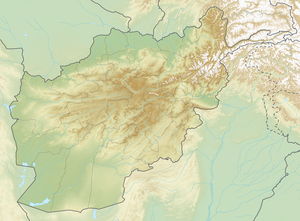Kayakai dam
| Kayakai dam | |||||||||
|---|---|---|---|---|---|---|---|---|---|
Kayakai dam with the hydroelectric power plant in the center of the picture
|
|||||||||
|
|||||||||
|
|
|||||||||
| Coordinates | 32 ° 19 ′ 19 ″ N , 65 ° 7 ′ 9 ″ E | ||||||||
| Data on the structure | |||||||||
| Construction time: | - 1952 - 1975 power plant |
||||||||
| Height of the barrier structure : | 100 m | ||||||||
| Crown length: | 270 m | ||||||||
| Power plant output: | 51.6 MW | ||||||||
| Data on the reservoir | |||||||||
| Altitude (at congestion destination ) | 1033.5 m | ||||||||
| Storage space | 1.2 * 10 9 m³ | ||||||||
| Catchment area | 47,000 km² | ||||||||
The Kajakai Dam (Band-e Kadschakī, Bandi-Kadzhakay) has dammed the Hilmend River in the Afghan province of Helmand since 1953 .
The reservoir extends into the northeastern neighboring province of Uruzgan . The dam is used to irrigate 142,000 hectares of agricultural land, around 90% of which is pastureland . It protects against flooding and supports the drinking water supply .
The outflow of the Hilmand at the Kajakai Dam is highest in spring. There are big differences over the years. There are measured values for 1953 to 1979. According to this, the average discharge in April over the years 1953 to 1979 fluctuates between 10 m³ / s and 114 m³ / s and in September between 2.2 m³ / s and 14.2 m³ / s. The drought that persisted from 1999 to 2005 could not be absorbed by the Kajakai dam. In particular, the Sistan Basin in the 500 km downstream border area with Iran was hardly reached by the Hilmand River.
power plant
In 1975 a hydroelectric power plant (2 * 16.5 MW) was installed with the help of the United States Agency for International Development (USAID) . A further expansion was no longer possible due to the Afghan civil war and the Soviet intervention . The hydropower plant has been refurbished since October 2002 and expanded to a capacity of 51.6 MW. The planned completion by 2007 has been delayed because of the fighting with the Taliban . By 2016, American spending on the still unfinished power plant rose to over $ 300 million.
According to a January 2004 study of future energy supplies in Afghanistan, only 234,000 customers were connected to the public electricity grid , 30% of them in Kabul alone , and only 6% of the population had electricity . It is therefore planned to increase the output by 50 - 100 MW with an additional “ Kajakai II ” hydropower plant . To do this, the dam must be raised. In September 2007, the US Geological Survey used a simulation of the water balance to investigate the effects of an increase in the storage target from the current 1033.5 m to 1045 m.
Political conflict
The runoff of the Hilmand River is a more than 100 year conflict between Iran and Afghanistan, which has not been resolved even after the 1973 contractually agreed 26 m³ / s. Iran made a written complaint to the Secretary General of the United Nations on September 20, 2001 . According to an investigation in July 2000 at the Kajakai dam and at the upstream hydrometric station in the Dihrawud district of Uruzgan province, the dam is said to have been closed. In 2006 the United Nations initiated a joint GEF project.
Web links
- Afghanistan District Maps: kajaki.pdf (95 kB) Kajaki District
- Afghanistan Topographic Maps with background: PI41-16.pdf (1.19 MB)
Scale: 1: 300,000 - Kajakai dam and surroundings -
USGS September 14, 2007: Scientific Investigations Report 2007-5148 (PDF, 4.2 MB)
Water-Balance Simulations of Runoff and Reservoir Storage for the Upper Helmand Watershed and Kajakai Reservoir, Central Afghanistan
Individual evidence
- ↑ USGS Scientific Investigations Report 2007–5148: The value is not based on an accurate measurement.
- ↑ a b c d USGS Scientific Investigations Report 2007–5148
- ^ A b c Afghan Energy Information Center (AEIC) Kajaki Hydro Electric Plant
- ↑ USAID May 21, 2007: Report No. 5-306-07-004-P
- ↑ https://www.propublica.org/article/afghanistan-waste-kajaki-dam-more-than-300-million-spent-still-not-done
- ↑ a b Afghan Energy Information Center (AEIC) Securing Afghanistan's Future ( Memento of the original from March 1, 2016 in the Internet Archive ) Info: The archive link was inserted automatically and has not yet been checked. Please check the original and archive link according to the instructions and then remove this notice.
- ^ Radio Free Europe 2005: Iran / Afghanistan: Still No Resolution For Century-Old Water Dispute
- ↑ Letter dated 20 September 2001 from the Permanent Representative of the Islamic Republic of Iran to the United Nations (PDF; 96 kB)
- ↑ UNEP Afghanistan: Post-Conflict and Disaster Management Branch ( Memento of the original from October 11, 2007 in the Internet Archive ) Info: The archive link was automatically inserted and has not yet been checked. Please check the original and archive link according to the instructions and then remove this notice.
- ↑ GEF International Waters projects: sistan-project-concept-paper.pdf (670 kB)



